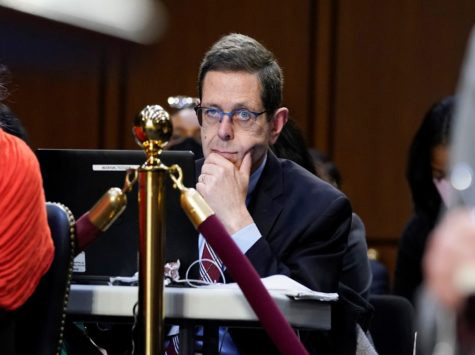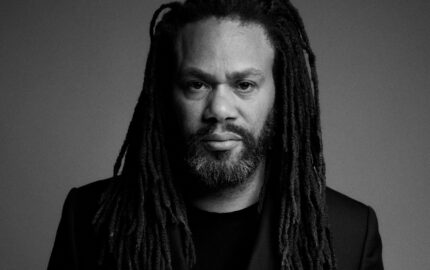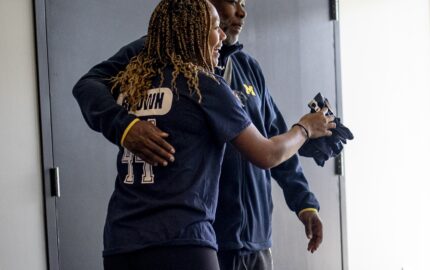EDITOR’S NOTE: This is one of four interviews with reporters who have made a specialty of covering the U.S. Supreme Court at a crucible time in the history of the Court and the press.
Associated Press reporter Mark Sherman has covered some of the Court’s most seismic decisions. A former Atlanta Journal-Constitution reporter, Sherman began covering the Court for the AP in 2006. He’s written — and is skilled at succinctly summarizing, as this YouTube video shows — decisions such as Obergefell v. Hodges, which legalized same-sex marriage nationwide; Shelby County v. Holder, which struck down a provision of the Voting Rights Act; and this year’s Dobbs decision overturning Roe v. Wade. As part of a one-two punch at the AP that also includes fellow Supreme Court reporter Jessica Gresko, Sherman often shows a deft touch, such as this lede noting a filing by the satirical website The Onion:
The Onion has some serious things to say in defense of parody.
Hurley is one of four veteran Supreme Court reporters who answered my questions about the challenges and strategies of covering complex and significant rulings under intense deadline pressure. His answers have been edited for length and clarity.
I’m no Supreme Court historian, but it seems clear this term is remarkable, both in terms of the impact of rulings but also how those rulings are being decided, announced and, in the case of Dobbs, leaked to the press and public. The coverage, including yours, has also been remarkable: insightful, clear and so fast. The question is whether, or how much of, the public is paying attention? When you write, who do you think about reaching, and how do you weigh the best way to reach them?

I think the public clearly was paying attention to the abortion case. We are reaching a broad audience, not schooled in the law, and so our stories have to be clear to those readers without sacrificing nuance.
Avoiding legalese is a must and describing the expected impact of the court’s decisions goes a long way in attracting readers and showing why cases are important. In the abortion story, for instance, the lead included a reference to roughly half the states being expected to ban or restrict abortion:
WASHINGTON (AP) — The Supreme Court on Friday stripped away women’s constitutional protections for abortion, a fundamental and deeply personal change for Americans’ lives after nearly a half-century under Roe v. Wade. The court’s overturning of the landmark court ruling is likely to lead to abortion bans in roughly half the states.
How did you come to covering the Supreme Court?
I was covering the Justice Department for AP when the beat came open. I raised my hand, interviewed with Sandy Johnson, our bureau chief at the time, and was selected. My predecessor was relocating so the transition was abrupt, and I was in place for the start of the new term in October 2006.
What was the largest challenge the beat posed, and how did you approach that challenge?
Understanding the subtler points in legal briefs was a huge challenge at first. I had never covered appellate courts in any sustained way. But I leaned on family and friends who are lawyers, and also did what any reporter does: I asked a lot of questions of the most prominent legal minds to help me understand what I was reading and what would happen if the Court adopted their arguments.
The Supreme Court beat
There are excellent Supreme Court reporters who studied law and others who didn’t; you’re in the latter camp. Are there any ways you believe a non-legal background helps or hurts in your current role?
As I mentioned, I think giving people easy to digest stories about the court is an ongoing challenge, and perhaps not having a legal background made it easier for me to do that. Hard to say, though. There are really talented writers and reporters in both categories.
How do you prepare for these major decisions so you can turn a thorough story so quickly? Do you make educated guesses on when a decision may be released? Do you pre-write based on what you believe to be likely outcomes?
It is not possible to do this job in anything approaching a competent way without thoroughly prepping for decisions. We pre-write several possible outcomes; and even within a particular outcome, there can be variations. In a case like the abortion decision, we prepped several outcomes and even had versions that had Chief Justice John Roberts in the majority and out. The Court can surprise you, although maybe less so lately. It doesn’t pay to ignore a possible outcome even if you think its chances are remote.
My philosophy tends to be: What would I tell my editor if the Court issued a decision and I didn’t have that version prepped after all these months.
As to timing, the biggest decisions usually come late in the term. But I start to prepare almost right away in the really big cases because there sometimes can be an off-ramp that the court might take quickly.
The Supreme Court seems like one the most opaque of the nation’s political institutions. How does that create challenges for — or maybe free up — those who write about the Court? How does it influence coverage of the Court as an institution?
It’s a curse, but also a blessing. The Court is an enigma to most of the country. That presents many opportunities for stories, about justices, the Court’s rituals and the decision-making process. The appetite is almost limitless, and that’s apart from coverage of the cases that are being heard.
***
Trevor Pyle was a newspaper reporter in the Pacific Northwest for several years, and is a communications officer for a regional nonprofit.



